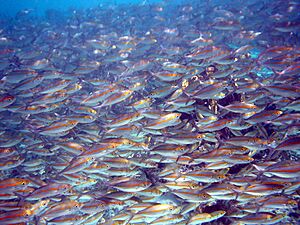Collective animal behaviour facts for kids


Collective animal behavior is all about how groups of animals act together. Think of a big group of fish swimming, or a flock of birds flying. Usually, all the animals in these groups are the same kind. For example, a school of fish will be mostly one type of fish. A herd is a large group of plant-eating mammals with hooves.
Animals often group together because it helps them in some way. A group of animals can do things that a single animal cannot. Studying collective behavior helps us understand the simple rules each animal follows. It also shows how they talk to each other and make decisions as a group.
Contents
Why Animals Group Together
Animals group together for many important reasons. These reasons help them survive and thrive.
Staying Safe from Predators
One big reason animals form groups is to protect themselves from other animals that might hunt them (called predators).
- Confusing Predators: Imagine a huge school of fish. When a predator tries to catch one, it's hard to pick out a single fish from the moving crowd. All the movement can make the predator confused.
- Many Eyes: The more animals in a group, the more eyes there are to look out for danger. If one animal spots a predator, it can warn the others. This means the group is safer, and each animal can spend more time eating.
- Safety in Numbers: If a predator attacks a big group, the chance of any one animal being caught is smaller. It's like hiding in a crowd. If you are in a bigger group, you are less likely to be the one chosen by the predator.
Finding Food Together
A group of animals can often find food more easily than a single animal. For example, a school of fish might work together to find good feeding spots.
Moving More Easily
Moving in a group can save energy for animals like fish or birds.
- Many large birds fly in flocks. This helps them use less energy.
- Birds flying in a V-shape can save 12% to 20% of the energy they would use flying alone.
- Studies show that birds like Red Knots and Dunlins fly faster in flocks than when they are by themselves.
Social Connections
Animals like Herring fish show that social interaction is important. If an animal is separated from its group, it can feel stressed. Being part of a group helps animals feel safe and connected.
Learning and Migration
For birds that migrate long distances or gather in huge flocks, like starlings, there are special benefits. Birds can learn a lot from each other. Younger birds might learn the best migration routes from older, more experienced birds in the flock.
Swarming Insects
The word "swarm" is often used for insects that move in very large numbers, even if they don't live in a fixed colony. There are many examples, like Army ants. One of the most studied examples is the locust.
Locust Swarms
Locusts are a special type of grasshopper. They can multiply very quickly when conditions are right. When there are too many of them, they come together in huge groups and migrate. Young locusts form "bands," and adult locusts form "swarms." These swarms can travel huge distances, eating all the crops in their path and causing great damage.
Locusts are actually the same species as regular grasshoppers. But when they get crowded, they change their bodies and behavior. This change is called "phase polymorphism." At first, people thought these different forms were separate species.
Scientists at Oxford University found that locusts swarm because of overcrowding. When their hind legs are touched a lot, it increases a chemical called serotonin in their bodies. This makes the locusts change color, eat much more, and breed more easily. Just a few touches per minute for four hours can make a locust transform into the swarming type.
Some of the biggest locust swarms have covered hundreds of square miles. They can contain billions of locusts! Stories of locust plagues appear in ancient texts like the Bible and the Koran. One famous example is from the Biblical Exodus, where locusts ate all the crops in Egypt.
How We Model Large Groups
Scientists try to understand how animals in a group behave by thinking they follow simple rules, such as:
- Move in the same direction as your neighbors.
- Stay close to your neighbors.
- Don't bump into your neighbors.
New studies show that an animal might only pay attention to five to seven other animals around it, no matter how far away they are. It then tries to move in line with them. Another idea is that animals keep track of all other animals within a certain distance to stay aligned.
Small Social Groups
Primates, like monkeys and apes, are a good example of animals that almost always live in small groups. These groups are often based on families, or a few families together. Sometimes, a strong male will lead a group of females and their young.
Images for kids
See also
 In Spanish: Comportamiento colectivo de los animales para niños
In Spanish: Comportamiento colectivo de los animales para niños



